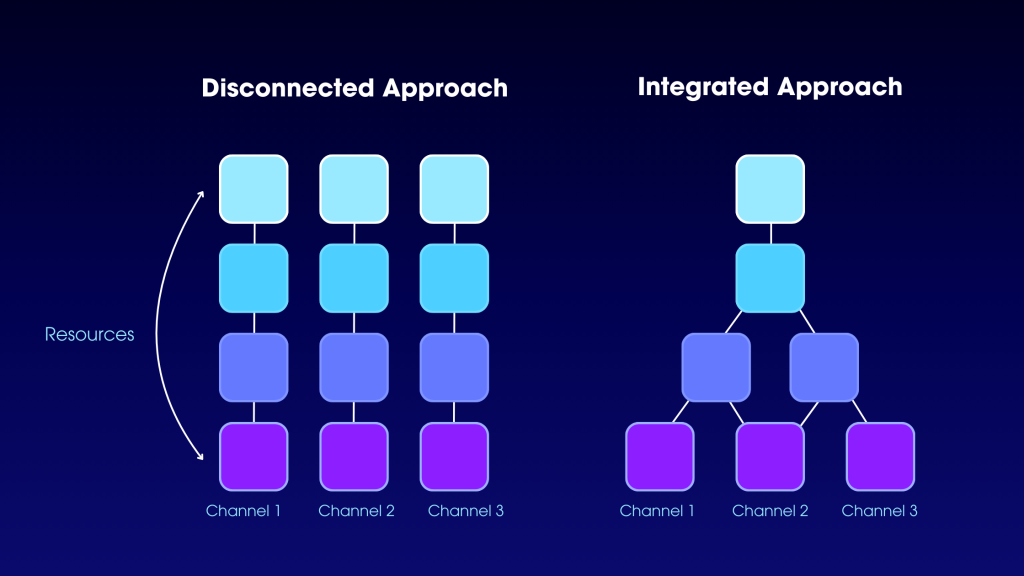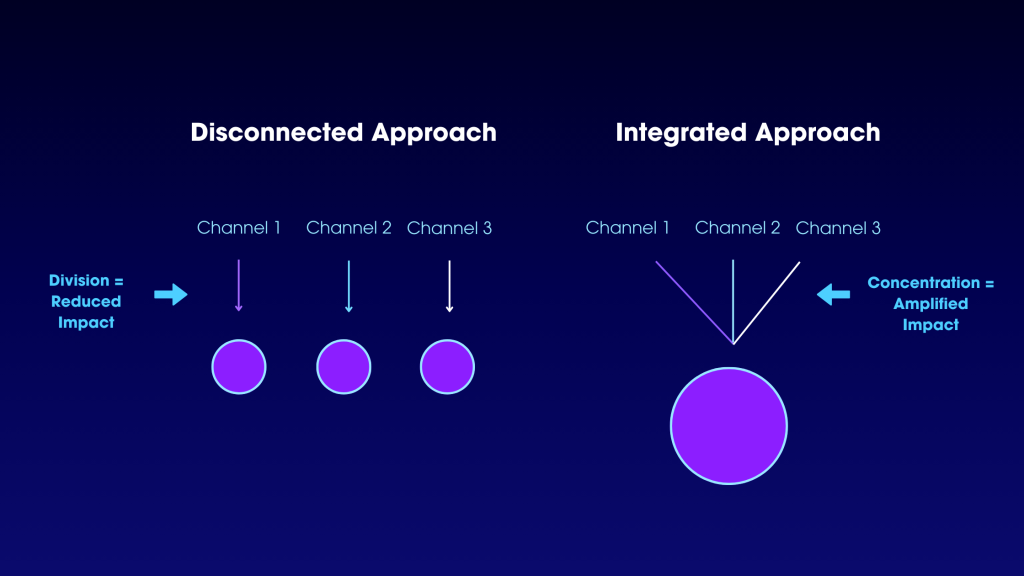Ever felt that your marketing efforts are disconnected? That you’re promoting your brand and offerings in different places … but without any kind of central guiding strategy tying them all together?
Now picture the opposite: one smooth go-to-market machine, seamlessly pushing out the same message and branding across every web page, social ad, and networking event. No matter where a current customer or potential buyer looks, they’re seeing the same thing – which helps them understand what you do and why you’re a great fit for their needs. That’s integrated marketing, and it’s what every organisation should be aiming for.
In this article, we’ll explain exactly what integrated marketing is and how adopting an integrated approach can improve your marketing ROI.
What Is Integrated Marketing?
‘Integrated marketing’ sounds complex, mysterious and novel – the kind of concept that could transform your marketing efforts. It’s none of those things.
Its actual definition: a unified go-to-market strategy where the same messages are delivered in roughly the same way across different channels. That’s not ‘integrated’ marketing. It’s just … marketing. The reason a standalone term exists is because, at large organisations, different departments sometimes own different channels. That can lead to differences in messaging and creative, especially if there’s no proper communication between stakeholder groups.
SMBs, in theory, shouldn’t have that problem. But they often do. Why? Because a lack of top-down processes means that, even in the absence of true departments, different stakeholders will often approach ‘their’ marketing channels in silos.
Here’s an example. A small law firm (under 20 staff) has 7 different marketing channels.
- The solicitors and practice manager engage in one-to-one business development at networking events.
- The front-desk admin runs the firm’s social media accounts on Facebook and LinkedIn.
- An external marketing agency manages the website and runs Google Ads campaigns. They also undertake technical SEO, but don’t have the in-house content expertise to run a proper SEO program.
- The firm gets around 40% of new business via word of mouth from past/current clients.
- It also receives a number of professional referrals from accountants, financial advisers, and other law firms.
The practice manager is technically responsible for coordinating everything, but has no way of knowing whether each channel is working. (The front-desk admin sometimes asks clients how they heard about the firm and records the results in their CRM, but it’s inconsistent and no-one looks at the data anyway.)
None of the stakeholders are working in a unified or ‘integrated’ way. There’s no centralised messaging. No coherent brand. No overarching strategy aligned around business goals. Each one is operating as an autonomous silo, which is a great way to get subpar results for a lot of wasted time, money, and effort.
We used a law firm as an example, but many small (and even mid-sized) businesses have similarly disconnected approaches to their marketing. It’s a problem – and one that can become fatal when the competitive landscape tightens.
How Integrated Marketing Can Improve ROI
All marketing is, ultimately, about improving return on investment. The higher your ROI, the more revenue you’re driving with your marketing budget. But a disconnected approach means you’ll struggle to even measure that number – let alone get a positive return. Here’s how integrating your marketing channels can change that.
Less Duplication
When marketing is delivered under a unified strategy, different stakeholders aren’t double-handling market research, message creation, or even asset production. That means you aren’t wasting resources on duplicated efforts; lower costs directly translate to higher ROI.

Better Decision-Making
All good marketing decisions are based on accurate, up-to-date data. You need a single, top-down approach to collecting and analysing data sets from different channels – particularly when it comes to attribution.
Let’s say the law firm we talked about earlier split its marketing budget evenly between BD, Facebook, LinkedIn, Google Ads, SEO, and referrer enablement. Under an integrated marketing approach, the firm’s partners could see exactly how much revenue each channel delivered, which could then be used to tweak budget allocations to improve total ROI.

Greater Effectiveness
Marketing is, in many ways, saying the right thing over and over again until it sinks in. Politicians have a good phrase for it: staying on message. If your marketing varies between channels, you’ll be less effective at having buyers understand and buy into your messaging, which directly compromises ROI. There’s always going to be a level of variance between channels, but your overall approach should be consistent and unified.

No Channel Biases
When different stakeholders own specific channels, they’ll inevitably become attached to them. The issue: that attachment clouds good judgement. If we think back to the law firm example, the external marketing agency will almost always defend Google Ads and SEO, even if those channels aren’t getting results. It will use misleading metrics to justify ongoing and even amplified investment in both, which will end up compromising marketing ROI. The same goes for internal stakeholders who don’t want to have their budgets cut.
You need a centralised decision-maker who can compare each channel’s performance, make appropriate resource allocations, and drive coordinated messaging and creative. At larger organisations, that person is a CMO. At the small business level, it’s a very good argument for working with a full-service marketing agency like us.
Unlike agencies that focus on a handful of services, our incentives aren’t tied to any single channel. We win when your marketing ROI improves – not when our slice of the pie gets bigger. And, because we work with every channel, we understand the pros and cons of each one, which results in a better strategy from the outset.
If you need help implementing a fully integrated marketing strategy – or unifying your existing efforts – schedule a consultation with us.












